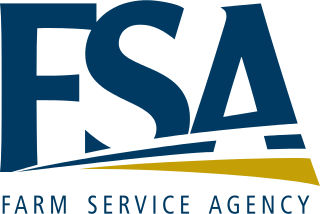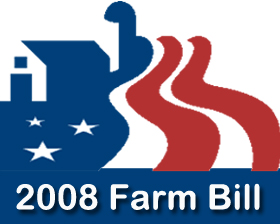Related Research Articles

The United States Department of Agriculture (USDA) is the federal executive department responsible for developing and executing federal laws related to farming, forestry, rural economic development, and food. It aims to meet the needs of commercial farming and livestock food production, promotes agricultural trade and production, works to assure food safety, protects natural resources, fosters rural communities and works to end hunger in the United States and internationally. It is headed by the Secretary of Agriculture, who reports directly to the President of the United States and is a member of the president's Cabinet. The current secretary is Tom Vilsack, who has served since February 24, 2021.

The Farm Service Agency (FSA) is the United States Department of Agriculture agency that was formed by merging the farm loan portfolio and staff of the Farmers Home Administration (FmHA) and the Agricultural Stabilization and Conservation Service (ASCS). The Farm Service Agency implements agricultural policy, administers credit and loan programs, and manages conservation, commodity, disaster, and farm marketing programs through a national network of offices. The Administrator of FSA reports to the Under Secretary of Agriculture for Farm Production and Conservation. The current Administrator is Richard Fordyce. The FSA of each state is led by a politically appointed State Executive Director (SED).

The Clean Water Act (CWA) is the primary federal law in the United States governing water pollution. Its objective is to restore and maintain the chemical, physical, and biological integrity of the nation's waters; recognizing the responsibilities of the states in addressing pollution and providing assistance to states to do so, including funding for publicly owned treatment works for the improvement of wastewater treatment; and maintaining the integrity of wetlands.
Natural Resources Conservation Service (NRCS), formerly known as the Soil Conservation Service (SCS), is an agency of the United States Department of Agriculture (USDA) that provides technical assistance to farmers and other private landowners and managers.

The Soil Conservation and Domestic Allotment ActPub.L. 74–461, enacted February 29, 1936) is a United States federal law that allowed the government to pay farmers to reduce production so as to conserve soil and prevent erosion.
The Commodity Credit Corporation (CCC) is a wholly owned United States government corporation that was created in 1933 to "stabilize, support, and protect farm income and prices". The CCC is authorized to buy, sell, lend, make payments, and engage in other activities for the purpose of increasing production, stabilizing prices, assuring adequate supplies, and facilitating the efficient marketing of agricultural commodities.

The Agricultural Adjustment Act of 1938 was legislation in the United States that was enacted as an alternative and replacement for the farm subsidy policies, in previous New Deal farm legislation, that had been found unconstitutional. The act revived the provisions in the previous Agriculture Adjustment Act, with the exception that the financing of the law's programs would be provided by the Federal Government and not a processor's tax, and was also enforced as a response to the success of the Soil Conservation and Domestic Allotment Act of 1936.

The Conservation Reserve Program (CRP) is a cost-share and rental payment program of the United States Department of Agriculture (USDA). Under the program, the government pays farmers to take certain agriculturally used croplands out of production and convert them to vegetative cover, such as cultivated or native bunchgrasses and grasslands, wildlife and pollinators food and shelter plantings, windbreak and shade trees, filter and buffer strips, grassed waterways, and riparian buffers. The purpose of the program is to reduce land erosion, improve water quality and effect wildlife benefits.
American Farmland Trust is a nonprofit organization in the United States that works to protect farmland, promote environmentally sound farming practices, and keep farmers on the land. AFT is staffed by farmers, policy experts, researchers and scientists, and governed by a board of directors. Its headquarters are in Washington, D.C., and it has regional offices throughout the country. AFT also runs the Farmland Information Center, an online collection of information on farmland and ranchland protection and stewardship established as a public-private partnership with the USDA Natural Resources Conservation Service.

In the United States, the farm bill is the primary agricultural and food policy instrument of the federal government. Every five years, Congress deals with the renewal and revision of the comprehensive omnibus bill.
The Conservation Security Program (CSP) was a voluntary conservation program in the United States that supported stewardship of private agricultural lands by providing payments and technical assistance for maintaining and enhancing natural resources. The program promoted the conservation and improvement of soil, water, air, energy, plant and animal life, and other conservation purposes. Congress established the CSP under the Farm Security and Rural Investment Act of 2002 (FSRIA), which amended the Food Security Act of 1985. The program was administered by the Natural Resources Conservation Service (NRCS), an agency of the United States Department of Agriculture (USDA).
The agricultural policy of the United States is composed primarily of the periodically renewed federal U.S. farm bills. The Farm Bills have a rich history which initially sought to provide income and price support to US farmers and prevent them from adverse global as well as local supply and demand shocks. This implied an elaborate subsidy program which supports domestic production by either direct payments or through price support measures. The former incentivizes farmers to grow certain crops which are eligible for such payments through environmentally conscientious practices of farming. The latter protects farmers from vagaries of price fluctuations by ensuring a minimum price and fulfilling their shortfalls in revenue upon a fall in price. Lately, there are other measures through which the government encourages crop insurance and pays part of the premium for such insurance against various unanticipated outcomes in agriculture.
The Conservation Farm Option Program was authorized by a provision of the 1996 farm bill. It is a pilot program for producers who received production flexibility payments to enter into a contract to consolidate payments at rates that were equivalent to payments that would otherwise be received from the Conservation Reserve Program, Wetlands Reserve Program, and/or the Environmental Quality Incentives Program in exchange for implementing practices to protect soil, water, and wildlife.

The Environmental Quality Incentives Program (EQIP) is a United States government program designed to assist farmers in improving environmental quality, particularly water quality and soil conservation. Congress established the program in the 1996 farm bill to provide primarily cost-sharing assistance, but also technical and educational assistance, aimed at promoting production and environmental quality, and optimizing environmental benefits.

The Food, Agriculture, Conservation, and Trade (FACT) Act of 1990 — P.L. 101-624 was a 5-year omnibus farm bill that passed Congress and was signed into law.
The Environmental Conservation Acreage Reserve Program (ECARP) was a United States umbrella program authorized by the Food, Agriculture, Conservation, and Trade Act of 1990 that includes the Conservation Reserve Program, and the Wetland Reserve Program. The Federal Agriculture Improvement and Reform Act of 1996 continued the CRP and WRP and created the Environmental Quality Incentives Program.
A poundage quota, also called a marketing quota, is a quantitative limit on the amount of a commodity that can be marketed under the provisions of a permanent law. Once a common feature of price support programs, this supply control mechanism ended with the quota buyouts for peanuts in 2002 and tobacco in 2004.
The Grasslands Reserve Program (GRP) was a United States government program, administered by the Natural Resources Conservation Service, that provided financial assistance to farmers and landowners to restore grasslands. The 2002 farm bill authorized enrollment of 2 million acres (8,100 km2) of restored or improved grassland, range land and pastureland under temporary and permanent easements, or contracts of at least 10 years. Under the GRP enrolled land must be in parcels that exceed 40 acres (160,000 m2). Technical assistance was provided to restore grasslands. A total of $254 million in mandatory funding from the Commodity Credit Corporation (CCC) was provided between Fiscal Years 2003 and 2007. It also provided cost sharing payments at 75% to restore disturbed grasslands and 90% to protect virgin grasslands.
United States policy in regard to biofuels, such as ethanol fuel and biodiesel, began in the early 1990s as the government began looking more intensely at biofuels as a way to reduce dependence on foreign oil and increase the nation's overall sustainability. Since then, biofuel policies have been refined, focused on getting the most efficient fuels commercially available, creating fuels that can compete with petroleum-based fuels, and ensuring that the agricultural industry can support and sustain the use of biofuels.
Public service law in the United States is the body of law, primarily based on a multitude of statutes, which establishes and organizes the delivery of public services in the United States.
References
- ↑ United States. Soil Conservation and Domestic Allotment Act of 1936. Pub.L. 74–461 Approved February 29, 1936.
- ↑ "Honoring 85 Years of NRCS – A Brief History". Washington, D.C.: U.S. Natural Resources Conservation Service. Retrieved 2020-05-17.
- ↑ United States. Federal Agriculture Improvement and Reform Act of 1996. Pub.L. 104–127 (text) (PDF) Approved April 4, 1996.
 This article incorporates public domain material from the Congressional Research Service document: Jasper Womach. "Report for Congress: Agriculture: A Glossary of Terms, Programs, and Laws, 2005 Edition" (PDF).[ dead link ]
This article incorporates public domain material from the Congressional Research Service document: Jasper Womach. "Report for Congress: Agriculture: A Glossary of Terms, Programs, and Laws, 2005 Edition" (PDF).[ dead link ]